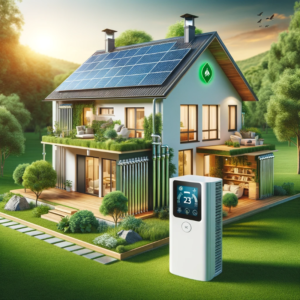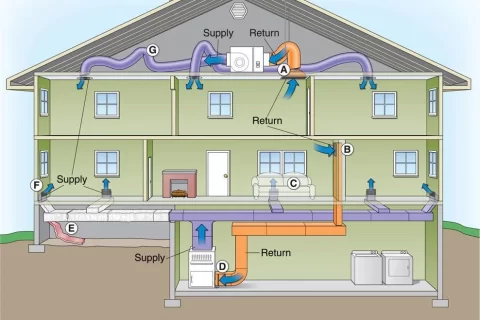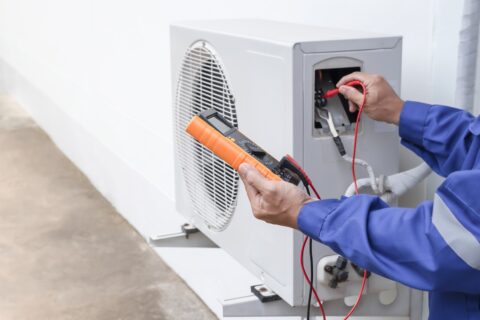Eco-Friendly Air Conditioning: Tips for Sustainable Cooling Solutions
Want to keep your cool while being kind to the planet? AC eco-friendly operation tips can help you save energy and reduce your carbon footprint. Simple changes in how you use your air conditioning can make a big difference. Adjusting the thermostat, using fans, and sealing leaks are just a few friendly air conditioning options to boost efficiency in your HVAC system.
These tips not only help the environment but also lower your energy bills by using friendly air conditioning options and optimizing your HVAC system with the right information about your air conditioner. Being eco-conscious doesn’t mean sacrificing comfort. With these easy strategies, you can enjoy a chill space without guilt.
Key Takeaways
-
Prioritize eco-friendly AC systems to lower your carbon footprint and save on energy costs.
-
Reduce energy use by setting your thermostat a few degrees higher in summer and lower in winter.
-
Invest in smart thermostats that can adjust temperatures based on your schedule, enhancing efficiency.
-
Choose AC units that use eco-friendly refrigerants to minimize environmental harm.
-
Schedule regular maintenance for your AC to ensure it operates efficiently and lasts longer.
-
Improve your home’s insulation to reduce the workload on your AC system, leading to lower energy consumption.
Importance of Eco-Friendly AC
Environmental Benefits
Eco-friendly air conditioners offer significant environmental benefits. They use less energy than traditional systems. This reduction in energy usage leads to lower greenhouse gas emissions. For example, the U.S. Environmental Protection Agency (EPA) states that friendly air conditioning options, such as energy-efficient HVAC systems, can reduce emissions by 30% or more, providing information on their family features.
These systems often utilize refrigerants that have less impact on the ozone layer. Traditional refrigerants can contribute to global warming. In contrast, eco-friendly options minimize this effect. By choosing an eco-friendly AC with family features, individuals help protect the environment by using information.
Cost Savings
Long-term cost savings are a major advantage of energy-efficient HVAC systems. While eco-friendly air conditioners may cost more upfront, they save money over time. These friendly air conditioning options consume less energy, leading to lower utility bills. According to the Department of Energy, homeowners can save up to 20% on cooling costs.
Many regions offer rebates and incentives for installing friendly air conditioning options and energy-efficient systems. This financial assistance helps offset initial installation costs. Over time, these savings can add up significantly. Homeowners benefit from both reduced expenses and increased comfort.
Reducing Carbon Footprints
Eco-friendly AC plays a critical role in reducing carbon footprints. Every kilowatt-hour saved is one less produced from fossil fuels, thanks to friendly air conditioning options. Fossil fuel combustion releases carbon dioxide into the atmosphere. By using energy-efficient systems, individuals contribute to a cleaner environment.
Moreover, these systems support efforts to combat climate change. The Intergovernmental Panel on Climate Change (IPCC) emphasizes the need for reduced emissions globally, including friendly air conditioning options. Switching to eco-friendly air conditioning is one way individuals can take action.
System Efficiency
Efficiency is key when considering an air conditioner eco option. Systems with high Seasonal Energy Efficiency Ratio (SEER) ratings are more effective at cooling spaces while using less energy. A SEER rating of 14 or higher is recommended for optimal performance in friendly air conditioning options.
Regular maintenance also enhances system efficiency. Cleaning filters and scheduling annual inspections keeps friendly air conditioning options running smoothly. This proactive approach extends the lifespan of the system and maintains its eco-friendly benefits.
Reduce Energy Use in AC
Monitor Energy Bills
Regularly checking energy bills helps identify spikes in usage. High bills often signal inefficiencies in the air conditioning system. By tracking these changes, homeowners can pinpoint issues with their friendly air conditioning options and HVAC systems. For example, a sudden increase might indicate that the air conditioner is working harder than necessary.
Homeowners should compare bills month to month. This practice reveals patterns and helps set benchmarks for friendly air conditioning options and energy use. If energy costs rise unexpectedly, it may be time to call a technician for an inspection.
Optimize Settings
Adjusting the thermostat settings can significantly lower energy consumption. Setting the temperature higher during the day when no one is home reduces strain on the air conditioning unit. A recommended setting is around 78°F when occupied and 85°F when unoccupied, providing friendly air conditioning options. These adjustments lead to noticeable savings without sacrificing comfort.
Using programmable thermostats adds convenience and efficiency. These devices allow users to set schedules based on daily routines, including friendly air conditioning options. This way, the friendly air conditioning system only runs when needed.
Maintain Your Unit
Routine maintenance of the air conditioning unit is crucial for efficiency. Cleaning or replacing filters every month improves airflow and reduces energy use. Clogged filters force the system to work harder, which increases energy consumption and limits friendly air conditioning options.
Scheduling friendly air conditioning options and professional inspections once a year keeps systems running smoothly. Technicians check for refrigerant levels and inspect ductwork for leaks. Addressing these issues ensures optimal performance and lowers energy demand.
Seal Leaks
Sealing air leaks around windows and doors prevents cool air from escaping. Simple weatherstripping or caulking, along with friendly air conditioning options, can make a significant difference in maintaining indoor temperatures. This practice reduces the workload on room air conditioners or central systems.
Insulating ducts also plays a vital role in efficiency. Proper insulation minimizes temperature loss as air travels through ducts. This step ensures that cooled air reaches its destination without unnecessary waste.
Use Energy-Efficient Appliances
Investing in friendly air conditioning options and energy-efficient appliances pays off in the long run. Look for products with the ENERGY STAR label, indicating they meet strict efficiency guidelines. Upgrading to modern HVAC systems can reduce energy consumption by up to 50%.
Consider using ceiling fans to complement air conditioning. Fans circulate cool air more effectively and allow higher thermostat settings without sacrificing comfort.
Implement Smart Practices
Adopting smart practices contributes to overall energy savings. Close curtains during peak sunlight hours to keep homes cooler naturally with friendly air conditioning options. This simple action reduces reliance on air conditioning units, leading to lower energy bills.
Encouraging family members to adopt these habits fosters an eco-friendly mindset at home. Simple steps, like using friendly air conditioning options, can create a culture of sustainability within households.
Use Smart Thermostats
Optimize Temperature
Smart thermostats help maintain ideal temperatures. They adjust settings based on occupancy patterns. This means the system works efficiently only when needed. For example, if no one is home, the friendly air conditioning options allow the thermostat to raise the temperature. This reduces energy waste.
These devices learn your habits over time. They can automatically change friendly air conditioning options as you come and go. By doing this, they ensure that efficient HVAC systems run optimally. Traditional HVAC systems often cool or heat spaces unnecessarily. Smart thermostats prevent this by responding to real-time needs.
Remote Access
Many smart thermostats offer remote access features. Users can control their heating system from anywhere using a smartphone app. If plans change and you are away longer than expected, adjustments are easy. You can lower the temperature while on vacation and raise it before returning home.
This feature supports friendly HVAC practices. It allows for more precise temperature management. Users save money by avoiding unnecessary heating or cooling while away. Remote access also enhances comfort upon arrival back home.
Energy Savings Education
Educating users about energy savings is crucial. Many do not realize how much they can save with smart technology. Automating temperature control leads to significant reductions in energy bills. Studies show that households can save up to 10-15% on heating and cooling costs annually.
Users should understand how these savings add up over time. For example, if a family spends $2,000 yearly on energy, saving 10% equates to $200 each year. Over five years, that totals $1,000 saved just by using smart thermostats.
Steps to Implement
-
Choose a compatible smart thermostat.
-
Follow installation instructions carefully.
-
Connect the device to your Wi-Fi network.
-
Download the associated app on your smartphone.
-
Set up preferences based on your schedule.
Following these steps ensures effective use of friendly HVAC solutions. Proper setup maximizes the benefits of smart thermostats.
Choose Eco-Friendly Refrigerants
Low Global Warming Potential
Selecting refrigerants with low global warming potential is essential. These substances have a reduced impact on climate change compared to traditional options. For instance, hydrofluorocarbons (HFCs) are commonly used but can contribute significantly to global warming.
Alternatives like hydrocarbon refrigerants or natural refrigerants such as ammonia and carbon dioxide are more sustainable choices. They offer efficient cooling while minimizing environmental damage. Choosing these eco-friendly options supports a healthier planet.
Newer Technologies
Researching and adopting newer refrigerant technologies is crucial. Many companies now develop refrigerants that comply with strict environmental regulations. These innovations focus on reducing the ecological footprint of HVAC systems.
For example, some manufacturers have introduced refrigerants that break down faster in the atmosphere. This characteristic lowers their long-term impact on global warming. Implementing these technologies can enhance the sustainability of any air conditioning system.
Advocate for Transition
Advocating for the transition to sustainable refrigerants is necessary in the HVAC world. Many professionals can educate clients about the benefits of eco-friendly air conditioning options. This education includes explaining how these alternatives can meet their cooling needs effectively.
Working with a competent air conditioning provider helps facilitate this transition. They can recommend friendly air conditioners that utilize sustainable refrigerants. This approach not only benefits the environment but also improves energy efficiency.
Benefits of Sustainable Refrigerants
-
Reduced Environmental Impact: Using low-global-warming-potential refrigerants lessens harm to our planet.
-
Compliance with Regulations: Newer refrigerant options often meet current environmental laws.
-
Enhanced Efficiency: Many eco-friendly refrigerants provide efficient cooling without sacrificing performance.
-
Long-term Savings: Sustainable systems may lead to lower energy costs over time.
Choosing eco-friendly refrigerants aligns with modern values of sustainability and responsibility. It reflects a commitment to creating a better future for everyone.
Regular AC Maintenance
Routine Inspections
Schedule routine inspections for your air conditioning system. These checks help identify issues early. A professional can spot problems that homeowners might miss. Regular inspections keep the system running efficiently. They also help maintain comfort levels in the home.
Experts recommend having inspections done at least once a year. This is especially important before the summer season. An AC unit that runs well uses less energy. This means lower utility bills. It also reduces wear and tear on the equipment.
Filter Changes
Homeowners must understand the importance of filter changes. Clogged filters restrict airflow, making the system work harder. This increases energy consumption and costs. Dirty filters can also affect indoor air quality.
Change your air filters every 1 to 3 months. The frequency depends on usage and filter type. Some filters last longer than others, but regular checks are essential. Clean filters improve airflow and efficiency. They also help extend the lifespan of the HVAC system.
Prompt Repairs
Encourage prompt repairs when issues arise. Delaying repairs can lead to bigger problems later. For example, a small refrigerant leak can turn into a major repair if ignored. Quick fixes prevent energy waste and save money in the long run.
Homeowners should be aware of warning signs. Unusual noises, strange smells, or inconsistent temperatures indicate potential issues. Addressing these signs quickly can prevent costly breakdowns.
Energy Efficiency
Regular maintenance enhances energy efficiency. An efficient AC system consumes less energy, which is better for the environment. Homeowners can contribute to eco-friendly practices by maintaining their systems properly.
Using energy-efficient appliances also plays a role in sustainability. Many modern units use less energy than older models. When combined with regular maintenance, these units perform optimally while reducing environmental impact.
Seasonal Preparation
Prepare your air conditioning unit for seasonal changes. Before summer, ensure it’s ready for heavy use. Check refrigerant levels and clean coils to maximize performance.
In winter, cover outdoor units to protect them from snow and ice damage. Proper preparation extends the life of your HVAC system.
Improve Home Insulation
Assess Insulation Materials
Home heating relies heavily on good insulation. Many homes have outdated materials that do not work efficiently. Upgrading to modern insulation can save energy. Materials like spray foam and fiberglass are effective options. They help maintain a cool home environment in summer and retain heat in winter.
Proper insulation reduces the need for heating and cooling systems to work as hard. This leads to lower energy bills. It also minimizes the carbon footprint of your home. A well-insulated house is more comfortable year-round.
Seal Air Leaks
Air leaks are common culprits in energy loss. Gaps around windows and doors allow air to escape or enter. This can lead to inconsistent indoor temperatures. Sealing these leaks is an easy yet effective way to improve energy efficiency.
Use weather stripping or caulk to seal gaps. Check areas like baseboards, electrical outlets, and vents. These small fixes can make a big difference in maintaining desired temperatures. Proper sealing helps reduce the workload on HVAC systems.

Benefits of Proper Insulation
Proper insulation offers several benefits beyond comfort. It significantly reduces the workload on heating, ventilation, and air conditioning (HVAC) systems. Less strain on these systems means they last longer and require fewer repairs.
Energy-efficient homes contribute to environmental sustainability. They use less energy, which decreases greenhouse gas emissions. Homeowners may qualify for tax credits by improving their insulation.
Investing in insulation upgrades pays off over time. Homeowners often see a return on investment through lower utility bills. The initial costs can be recouped within a few years.
Improved insulation enhances overall home value too. Buyers look for energy-efficient features when making decisions. A well-insulated home stands out in the market.
Regular Maintenance
Regular maintenance of insulation is vital for long-term effectiveness. Homeowners should check insulation every few years for wear and tear. Signs of damage include mold growth, moisture, or pest infestations.
Addressing these issues quickly can prevent larger problems down the road. Maintaining good insulation keeps homes comfortable and energy-efficient.
Consider Renewable Energy Options
Solar Panels
ar panel installations offer a sustainable way to power HVAC systems. These panels convert sunlight into electricity. This energy can directly power heating and cooling units. Homes with solar panels experience lower energy bills. They also reduce the carbon footprint.
Many states provide incentives for installing solar panels. Tax credits and rebates can lower installation costs. Homeowners should research local programs. Some utilities even offer net metering. This allows homeowners to sell excess energy back to the grid.
Local Incentives
Investigating local incentives is crucial for adopting renewable energy options. Many governments support eco-friendly initiatives. They may offer financial assistance or grants for green technology. This includes sustainable HVAC system options.
Local utility companies often have programs to encourage energy efficiency. These programs might include discounts on energy-efficient appliances or HVAC upgrades. Homeowners should contact their utility provider for details.
Renewable Energy Sources
Encouraging the integration of renewable energy sources is vital. This reduces reliance on fossil fuels significantly. Using eco heating options like geothermal systems can be beneficial. These systems use the earth’s natural heat to warm homes efficiently.
Wind energy is another option worth considering. Small wind turbines can generate electricity for residential use. Combining wind and solar can maximize energy efficiency.
Eco-Friendly HVAC Options
Choosing friendly HVAC options makes a difference in energy consumption. Many manufacturers now produce green HVAC options that are both efficient and effective. Systems with high SEER ratings consume less energy while providing better comfort.
Investing in smart thermostats can improve control over heating and cooling. These devices learn user preferences and adjust settings automatically, leading to further savings.
Sustainable Heating Solutions
Sustainable heating solutions focus on reducing environmental impact. Heat pumps are an example of this technology. They transfer heat rather than generate it, making them highly efficient.
Biomass heating systems also present eco-friendly choices. They burn organic materials for heat, which can be more sustainable than traditional methods.
Family Features
Consider family features when selecting HVAC systems. Systems that operate quietly enhance comfort at home. Features like air purification can improve indoor air quality as well.
Families benefit from understanding their usage patterns too. Adjusting settings based on peak hours can lead to significant savings on bills.
Benefits of Zoning Systems
Tailored Comfort
Zoning systems allow for tailored heating and cooling in different areas of a home. Each zone can have its own thermostat. This setup means that rooms can be heated or cooled according to their specific needs. For example, a living room may require more cooling during the day, while bedrooms need warmth at night.
This flexibility helps homeowners manage temperature preferences better. Families often have different comfort levels. With zoning, everyone can enjoy their ideal environment without compromise.
Energy Savings
Energy savings are significant with zoning systems. By conditioning only occupied spaces, homeowners reduce energy waste. For instance, if no one is in the guest bedroom, there’s no need to heat or cool it. This targeted approach can lead to lower utility bills.
Studies show that homes with zoning systems can save up to 30% on energy costs. This is especially true in larger homes where some areas may remain unused for long periods.
Improved Comfort Levels
Personalized temperature control improves overall comfort levels in a home. Zoning allows for adjustments based on individual preferences. Some family members might prefer a cooler environment, while others like it warmer.
This system also helps manage humidity levels effectively. Proper humidity control contributes to a healthier indoor environment. It prevents mold growth and keeps air fresh.
Zoning systems enhance comfort by providing consistent temperatures throughout the house. No more hot or cold spots disrupt relaxation. Everyone enjoys an even climate tailored to their needs.
Practical Features
Zoning systems come with practical features that add value to the home. Smart thermostats allow remote control via smartphones. Homeowners can adjust temperatures from anywhere, ensuring comfort upon arrival.
Zoning systems integrate well with renewable energy options discussed earlier. They work efficiently alongside solar panels or geothermal systems, maximizing energy use.
Closing Thoughts
Embracing eco-friendly AC practices is a smart move for both your wallet and the planet. By reducing energy use, opting for smart thermostats, and maintaining your system, you can enjoy comfort while minimizing your carbon footprint. Choosing eco-friendly refrigerants and improving home insulation further enhance efficiency, making a real difference in your energy bills.
Take action today! Explore renewable energy options and consider zoning systems to maximize your cooling experience. Every small change counts toward a greener future. You have the power to make an impact—start implementing these tips now for a sustainable tomorrow.
Frequently Asked Questions
What are the benefits of an eco-friendly AC system?
Eco-friendly AC systems reduce energy consumption, lower utility bills, and minimize environmental impact. They often use advanced technology for efficiency and can improve indoor air quality.
How can I reduce energy use in my AC?
To reduce energy use, set your thermostat higher, keep filters clean, and seal any leaks in ducts. Regular maintenance also enhances efficiency.
What is a smart thermostat?
A smart thermostat learns your schedule and adjusts temperatures accordingly. It helps optimize energy usage, saving you money while maintaining comfort.
Why should I choose eco-friendly refrigerants?
Eco-friendly refrigerants have lower global warming potential and are less harmful to the ozone layer. They contribute to a more sustainable environment.
How often should I maintain my AC unit?
Regular maintenance should be performed at least once a year. This ensures optimal performance, extends the life of your unit, and improves efficiency.
How does home insulation affect my AC’s efficiency?
Good home insulation keeps cool air inside during summer and reduces workload on your AC. This leads to lower energy bills and improved comfort.
What are zoning systems in HVAC?
Zoning systems allow you to control temperatures in different areas of your home independently. This increases comfort and energy efficiency by directing airflow where it’s needed most.


